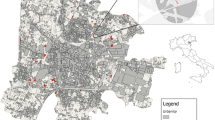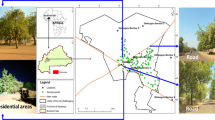Abstract
Urban forests adjacent to interstate corridors are understudied ecosystems across cities. Despite their small area, these forests may be strategically located to provide large ecosystem services due to their ability to act as a barrier against air pollutants and noise as well as to provide flood control. The woody vegetation composition and structure of forests adjacent to urban interstates is an important determinant of their ability to provide these services. However, these forest communities may be particularly susceptible to the introduction of exotic invasive species via the interstate and the surrounding city that can potentially alter current and future forest composition. The purpose of this study was to investigate the distribution of native and exotic woody vegetation and tree regeneration in forests along three interstate corridors in Louisville, KY, and to determine potential factors (e.g., traffic density) that are correlated with patterns in the woody vegetation community. We found the most important determinants of vegetation composition along these interstate corridors were the distance from the city center and the presence of an exotic invasive shrub, Amur honeysuckle (Lonicera maackii). Compared with forested plots within 10 km of the city center, plots further from the city center had 81% lower stem density of Amur honeysuckle, 96% higher tree seedling regeneration, and 51% greater woody plant species richness. The primarily native species composition of adult trees in forests alongside urban interstates in Louisville and the regeneration of native tree species provide optimism that these forests can maintain native species while experiencing multiple impacts from the interstate as well as from the surrounding city, emphasizing their important potential for maintaining natural forest functions across the urban landscape.






Similar content being viewed by others
References
Anderson LM, Mulligan BE, Goodman LS (1984) Effects of vegetation on human response to sound. J Arboric 10(2):45–49
Arévalo JR, Delgado JD, Otto R, Naranjo A, Salas M, Fernandez-Palacios JM (2005) Distribution of alien vs. native plant species in roadside communities along an altitudinal gradient in Tenerife and Gran Canaria (Canary Islands). Perspect Plant Ecol, Evol Syst 7:185–202
Bartuszevige AM, Gorchov DL (2006) Avian seed dispersal of an invasive shrub. Biol Invasions 8:1013–1022
Bolund P, Hunhammar S (1999) Ecosystem services in urban areas. Ecol Econ 29:293–301
Borgmann KL, Rodewald AD (2005) Forest restoration in urbanizing landscapes: interactions between land uses and exotic shrubs. Restor Ecol 13(2):334–340
Botkin DB, Beveridge CE (1997) Cities as environments. Urban Ecosyst 1:3–19
Chen WY, Jim CY (2008) Assessment and valuation of the ecosystem services provided by urban forests. In: Carreiro MM, Song Y-C, Wu J (eds) Ecology, planning, and management of urban forests: international perspectives. Springer, New York
Collier MH, Vankat JL, Hughes MR (2002) Diminished plant richness and abundance below Lonicera maackii, an invasive shrub. Am Midl Nat 147:60–71
Dorning M, Cipollini D (2006) Leaf and root extracts of the invasive shrub, Lonicera maackii, inhibit seed germination of three herbs with no autotoxic effects. Plant Ecol 184:287–296
Dufrêne M, Legendre P (1997) Species assemblages and indicator species: the need for a flexible asymmetrical approach. Ecol Monogr 67:345–366
Duguay S, Eigenbrod F, Fahrig L (2007) Effects of surrounding urbanization on non-native flora in small forest patches. Landsc Ecol 22:589–599
Folke C, Jansson A, Larsson J, Costanza R (1997) Ecosystem appropriation by cities. Ambio 26(3):167–172
Forman RTT (2000) Estimate of the area affected ecologically by the road system in the United States. Conserv Biol 14(1):31–35
Forman RTT, Sperling D, Bissonette JA, Clevenger AP, Cutshall CD, Dale VH, Fahrig L, France R, Goldman CR, Heanue K, Jones JA, Swanson FJ, Turrentine T, Winter TC (2003) Road ecology. Science and solutions. Island Press, Washington
Gatz DF (1991) Urban precipitation chemistry: a review and synthesis. Atmos Environ 25B:1–15
Gelbard JL, Belnap J (2003) Roads as conduits for exotic plant invasions in a semiarid landscape. Conserv Biol 17(2):420–432
Gleason HA, Cronquist A (1991) Manual of vascular plants of Northeastern United States and adjacent Canada, 2nd edn. The NY Botanical Garden, Bronx
Grantz DA, Garner JHB, Johnson DW (2003) Ecological effects of particulate matter. Environ Int 29:213–239
Hansen MJ, Clevenger AP (2005) The influence of disturbance and habitat on the presence of non-native plant species along transport corridors. Biol Conserv 125:249–259
Harris RA, Cohn LF (1985) Use of vegetation for abatement of highway traffic noise. J Urban Plan Dev 111(1):34–48
Heisler GM (1977) Trees modify metropolitan climate and noise. J Arboric 3(11):201–207
Hooper DU, Chapin FS III, Ewel JJ, Hector A, Inchausti P, Lavorel S, Lawton JH, Lodge DM, Loreau M, Naeem S, Schmid B, Setala H, Symstad AJ, Vandermeer J, Wardle DA (2005) Effects of biodiversity on ecosystem functioning: a consensus of current knowledge. Ecol Monogr 75(1):3–35
Hutchinson TF, Vankat JL (1997) Invasibility and effects of Amur honeysuckle in southwestern Ohio forests. Conserv Biol 11(5):1117–1124
Jo H-K, McPherson EG (1995) Carbon storage and flux in urban residential greenspace. J Environ Manag 45:109–133
Kruskal JB (1964) Nonmetric multidimensional scaling: a numerical method. Psychometrika 29:115–129
KYTC (Kentucky Transportation Cabinet) Traffic Count Program (2007) www.planning.kytc.ky.gov/
KYTC (Kentucky Transportation Cabinet) Projects Archive (1909–Present) (2008) http://kytcgis.ky.gov/projectarchive/viewer.htm
Lovett GM, Traynor MM, Pouyat RV, Carreiro MM, Zhu W, Baxter JW (2000) Atmospheric deposition to oak forests along an urban-rural gradient. Environ Sci Technol 34(20):4294–4300
Luken JO, Thieret JW (1996) Amur honeysuckle, its fall from grace. Lessons from the introduction and spread of a shrub species may guide future plant introductions. BioScience 46(1):18–24
Luken JO, Kuddes LM, Tholemeier TC (1997) Response of understory species to gap formation and soil disturbance in Lonicera maackii thickets. Restor Ecol 5(3):229–235
Mather PM (1976) Computational methods of multivariate analysis in physical geography. Wiley, London
McCune B, Grace JB, Urban DL (2002) Analysis of ecological communities. MjM Software, Gleneden Beach
McPherson EG, Nowak D, Heisler G, Grimmond S, Souch C, Grant R, Rowntree R (1997) Quantifying urban forest structure, function, and value: the Chicago Urban Forest Climate Project. Urban Ecosyst 1:49–61
Medley KE (1997) Distribution of the non-native shrub Lonicera maackii in Kramer Woods, Ohio. Phys Geogr 18(1):18–36
Muller RN (1982) Vegetation patterns in the mixed mesophytic forest of eastern Kentucky. Ecology 63(6):1901–1917
Muller RN, McComb WC (1986) Upland forests of the Knobs Region of Kentucky. Bull Torrey Bot Club 113(3):268–280
National Atlas of the United States (2009) Page last modified: September 17, 2009 http://www.nationalatlas.gov/mld/ecoomrp.html
National Atmospheric Deposition Program (NADP) (2010) Annual Data for Site: KY19 (Seneca Park). NADP Program Office, Champaign, IL. http://nadp.sws.uiuc.edu
National Climatic Data Center (NCDC) (2009) NOAA Satellite and Information Service. Page last modified: August 26, 2009. http://www.ncdc.noaa.gov/oa/ncdc.html
Nowak DJ, Walton JT (2005) Projected urban growth (2000–2050) and its estimated impact on the US forest resource. J For 103(8):383–389
Nowak DJ, McHale PJ, Ibarra M, Crane D, Stevens JC Luley CJ (1997) Modeling the effects of urban vegetation on air pollution. 22nd NATO/CCMS International Technical Meeting on Air Pollution Modeling and its Application. Clermont-Ferrand, France
Pauchard A, Alaback PB (2004) Influence of elevation, land use, and landscape context on patterns of alien plant invasions along roadsides in protected areas of south-central Chile. Conserv Biol 18(1):238–248
Rentch JS, Fortney RH, Stephenson SL, Adams HS, Grafton WN, Anderson JT (2005) Vegetation-site relationships of roadside plant communities in West Virginia, USA. J Appl Ecol 42:129–138
Schmidt W (1989) Plant dispersal by motor cars. Vegetatio 80:147–152
Smardon RC (1988) Perception and aesthetics of the urban environment: review of the role of vegetation. Landsc Urban Plan 15:85–106
Spellerberg IF (1998) Ecological effects of roads and traffic: a literature review. Glob Ecol Biogeogr Lett 7:317–333
Trammell TLE (2010) The forgotten forest: ecosystem structure, function, and services of forested verges along interstates in Louisville, KY. Dissertation, University of Louisville
Trammell TLE, Schneid BP, Carreiro MM (in press) Forest soils adjacent to urban interstates: Soil physical and chemical properties, heavy metals, disturbance legacies, and relationships with woody vegetation. Urban Ecosyst. doi:10.1007/s11252-011-0194-3
Trombulak SC, Frissell CA (2000) Review of ecological effects of roads on terrestrial and aquatic communities. Conserv Biol 14(1):18–30
U.S. Census Bureau (2001) Population change and distribution 1990–2000 in brief. http://www.census.gov/prod/2001pubs/c2kbr01-2.pdf
U.S. Census Bureau (2008) The 2009 Statistical Abstract. Page last modified: March 24, 2009. http://www.census.gov/compendia/statab/cats/population.html
United Nations, Department of Economic and Social Affairs, Population Division (2009) World Urbanization Prospects: The 2009 Revision. http://esa.un.org/unpd/wup/index.htm
Wace N (1977) Assessment of dispersal of plant species—the car-bourne flora in Canberra. Proc Ecol Soc Aust 10:167–186
Watkins RZ, Chen J, Pickens J, Brosofske KD (2003) Effects of forest roads on understory plants in a managed hardwood landscape. Conserv Biol 17(2):411–419
Zipperer WC, Guntenspergen GR (2009) Vegetation composition and structure of forest patches along urban-rural gradients. In: McDonnell MJ, Hahs AK, Breuste JH (eds) Ecology of cities and towns: a comparative approach. Cambridge University Press, New York
Acknowledgements
We thank Brad Schneid for field assistance on vegetation data collection. We also thank Cary Cassell for guidance on conducting highway research safely, Pat Haragan for assistance with woody plant identification, and Sarah Emery for advice on performing multivariate statistical analyses. The Department of Highways, KYTC granted permission to access the interstate rights-of-way and the Louisville Metro Parks granted permission to conduct research in Cherokee, Seneca, and Thurman-Hutchins Parks. We thank the University of Louisville Research Foundation IRIG and URG programs, the Kentucky Society of Natural History, and the USDA Forest Service NRS-4952 and SRS-4952 for funding.
Author information
Authors and Affiliations
Corresponding author
Appendix
Appendix
Rights and permissions
About this article
Cite this article
Trammell, T.L.E., Carreiro, M.M. Vegetation composition and structure of woody plant communities along urban interstate corridors in Louisville, KY, U.S.A.. Urban Ecosyst 14, 501–524 (2011). https://doi.org/10.1007/s11252-011-0193-4
Published:
Issue Date:
DOI: https://doi.org/10.1007/s11252-011-0193-4




